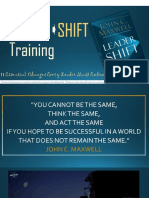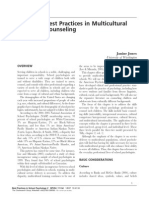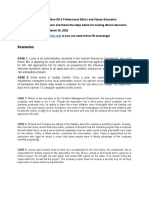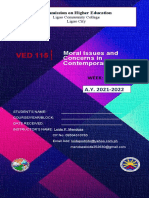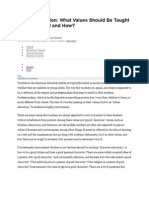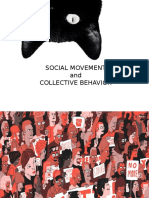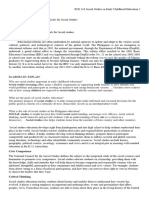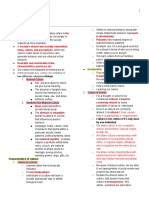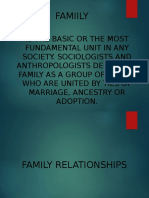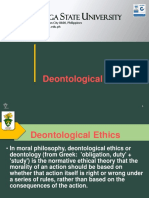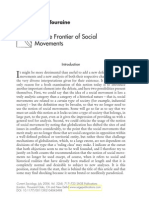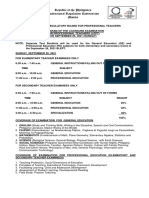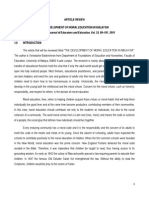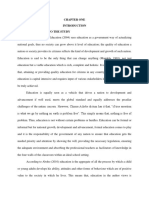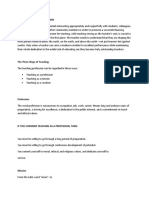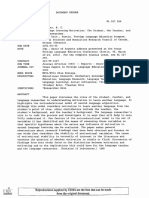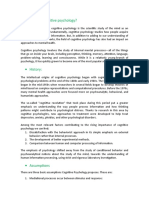Current Approaches To Moral Education
Current Approaches To Moral Education
Uploaded by
cvanaiduCopyright:
Available Formats
Current Approaches To Moral Education
Current Approaches To Moral Education
Uploaded by
cvanaiduOriginal Description:
Original Title
Copyright
Available Formats
Share this document
Did you find this document useful?
Is this content inappropriate?
Copyright:
Available Formats
Current Approaches To Moral Education
Current Approaches To Moral Education
Uploaded by
cvanaiduCopyright:
Available Formats
Current Approaches to Moral Education
The overwhelming percentage of efforts within public education to address the moral
domain currently marches under the flag of character education. Further, since these
conscious efforts at addressing issues of character formation are relatively recent, they
are often called character education programs. The term program suggests, however,
discrete initiatives that replace an activity or that are added to the school's curriculum
(e.g., a new reading program or mathematics program). And, although there are
character education programs available, commercially and otherwise, most advocates
urge the public schools to take an infusion approach to educating for character.
The infusion approach. n general, an infusion approach to character education
aims to restore the formation of students' characters to a central place in schooling.
!ather than simply adding on character formation to the other responsibilities of
schools, such as numeracy, literacy, career education, health education, and other goals,
a focus on good character permeates the entire school e"perience. n essence, character
education #oins intellectual development as the overarching goals of the school. Further,
character education is seen, not in competition with or ancillary to knowledge$ and skill$
ac%uisition goals, but as an important contributor to these goals. To create a healthy
learning environment, students need to develop the virtues of responsibility and respect
for others. They must eliminate habits of la&iness and sloppiness and ac%uire habits of
self$control and diligence. The infusion approach is based on the view that the good
habits that contribute to the formation of character in turn contribute directly to the
academic goals of schooling.
A mainstay of the infusion approach is the recovery, recasting, or creating of a school's
mission statement, one that reflects the priority placed on the development of good
character. 'uch a statement legitimi&es the attention of adults and students alike to this
educational goal. t tells administrators that teachers and staff should be hired with
good character as a criterion( it tells teachers that not only should character be stressed
to students but also their own characters are on display( it tells coaches that athletics
should be seen through the lens of sportsmanship rather than winning and losing( and it
tells students that their efforts and difficulties, their successes and disappointments are
all part of a larger process, the formation of their characters.
)ritical to the infusion approach is using the curriculum as a source of character
education. This is particularly true of the language arts, social studies, and history
curricula. The primary focus of these sub#ects is the study of human beings, real and
fictitious. *ur great narrative tales carry moral lessons. They convey to the young vivid
images of the kinds of people our culture admires and wants them to emulate. These
sub#ects also show them how lives can be wasted, or worse, how people can betray
themselves and their communities. +earning about the heroism of former slave
'o#ourner Truth, who became an evangelist and reformer, and the treachery of ,enedict
Arnold, the American army officer who betrayed his country to the ,ritish, is more than
picking up historical information. -ncountering these lives fires the student's moral
imagination and deepens his understanding of what constitutes a life of character. *ther
sub#ects, such as mathematics and science, can teach students the necessity of
1
intellectual honesty. The curricula of our schools not only contain the core knowledge of
our culture but also our moral heritage.
n addition to the formal or overt curriculum, schools and classrooms also have a hidden
or covert curriculum. A school's rituals, traditions, rules, and procedures have an impact
on students' sense of what is right and wrong and what is desired and undesired
behavior. 'o, too, does the school's student culture. .hat goes on in the lunchroom, the
bathrooms, the locker rooms, and on the bus conveys powerful messages to students.
This ethos or moral climate of a school is difficult to observe and neatly categori&e.
/evertheless, it is the focus of serious attention by educators committed to an infusion
approach.
An important element of the infusion approach is the language with which a school
community addresses issues of character and the moral domain. Teachers and
administrators committed to an infusion approach use the language of virtues and speak
of good and poor behavior and of right and wrong. .ords such as responsibility,
respect, honesty, and perseverance are part of the working vocabulary of adults and
students alike.
Other approaches. *ne of the most popular approaches to character education is
service learning. 'ometimes called community service, this approach is a conscious
effort to give students opportunities, guidance, and practice at being moral actors. ,ased
on the 0reek philosopher Aristotle's concept of character formation (e.g., a man
becomes virtuous by performing virtuous deeds( brave by doing brave deeds), many
schools and school districts have comprehensive programs of service learning. 'tarting
in kindergarten, children are given small chores such as feeding the classroom's gerbil
or straightening the desks and chairs. They later move on to tutoring younger students
and eventually work up to more demanding service activities in the final years of high
school. Typically, these high$school level service$learning activities are off$campus at a
home for the blind, a hospital, or a day$care center. ,esides placement, the school
provides training, guidance, and problem$solving support to students as they encounter
problems and difficulties.
n recent years, schools across the country have adopted the virtue (or value) of the
month approach, where the entire school community gives particular attention to a
%uality such as cooperation or kindness. )onsideration of the virtue for that particular
month is reflected in the curriculum, in special assemblies, in hallway and classroom
displays, and in school$home newsletters. !elated to this are schoolwide programs, such
as no put$downs pro#ects, where attention is focused on the destructive and hurtful
effects of sarcasm and insulting language and students are taught to replace put$downs
with civil forms of communication.
There are several skill$development and classroom strategies that are often related to
character formation. Among the more widespread are teaching mediation and conflict$
resolution skills, where students are given direct teaching in how to deal with
disagreements and potential fights among fellow students. 1any advocates of
cooperative learning assert that instructing students using this instructional process has
2
the added benefit of teaching students habits of helping others and forming friendships
among students with whom they otherwise would not mi".
Issues and Controversies
The moral education of children is a matter of deep concern to everyone from parents to
civic and religious leaders. t is no accident, then, that this sub#ect has been a matter of
apprehension and controversy throughout the history of American schools. ssues of
morality touch an individual's most fundamental beliefs. 'ince Americans are by
international standards both %uite religiously observant and %uite religiously diverse, it
is not surprising that moral and character education controversies often have a religious
source. 2articularly after a period when moral education was not on the agenda of most
public schools, its return is unsettling to some citi&ens. 1any who are hostile to religion
see this renewed interest in moral education as bringing religious perspectives back into
the school 3through the back door.3 *n the other hand, many religious people are
suspicious of its return because they perceive it to be an attempt to undermine their
family's religious$based training with a state$sponsored secular humanism. As of the
beginning of the twenty$first century, however, the renewed attention to this area has
been relatively free of controversy.
)ontributing to the positive climate is the use of the term character rather than moral.
.hile moral carries religious overtones for many, the word character speaks to good
habits and the civic virtues, which hold a community together and allow us to live
together in harmony.
A second issue relates to the level of schools and the age of students. The revival of
character education in our schools has been evident to a much greater degree in
elementary schools. 4ere schools can concentrate on the moral basics for which there is
wide public consensus. The same is true, but to a somewhat lesser degree, for middle
and #unior high schools. And although there are many positive e"amples of secondary
schools that have implemented broad and effective character education programs,
secondary school faculties are hesitant to embrace character education. 2art of it is the
departmental structures and the time demands of the curriculum( part of it is the age
and sophistication of their students( and part of it is that few secondary school teachers
believe they have a clear mandate to deal with issues of morality and character.
A third issue relates to the education of teachers. .hereas once teachers in training took
philosophy and history of education5courses that introduced them to the American
school's traditional involvement with moral and character education5now few states
re%uire these courses. At the beginning of the twenty$first century, the American schools
are seeing the large$scale retirement of career teachers and their replacement with large
numbers of new teachers. These young teachers tend to be products of elementary and
secondary schools where teachers gave little or no direct attention to moral and
character education. n addition, a 6777 study by the )haracter -ducation 2artnership
of half of the nation's teacher education institutions showed that although over 78
percent of the leaders of these programs thought character education ought to be a
3
priority in the preparation of teachers, only 69 percent were satisfied with their
institution's efforts.
Evaluation of Moral and Character Education
There are a few character education programs with encouraging evaluation results. The
)haracter :evelopment 2ro#ect ():2) has more than 6; years of involvement in several
<5= schools, and in those schools where teachers received staff development and on$site
support over >? percent of the student outcome variables showed significant differences.
The ,oy 'couts of America developed the +earning For +ife )urriculum in the early
6778s for elementary schools. This commercially available, stand$alone curriculum
teaches core moral values, such as honesty and responsibility. n a large$scale controlled
e"periment involving fifty$nine schools, students e"posed to the +earning For +ife
materials showed significant gains on their understanding of the curriculum's core
values, but they were also #udged by their teachers to have gained greater self$discipline
and ability to stay on a task.
'till, evaluation and assessment in character and moral education is best described as a
work in progress. The field is held back by the lack of an accepted battery of reliable
instruments, a lack of wide agreement on individual or schoolwide outcomes, and by the
short$term nature of most of the e"istent studies. )omplicating these limitations is a
larger one@ the lack of theoretical agreement of what character is. 4uman character is
one of those overarching entities that is the sub#ect of disciples from philosophy to
theology, from psychology to sociology. Further, even within these disciplines there are
competing and conflicting theories and understandings of the nature of human
character. ,ut although the evaluation challenges are daunting, they are dwarfed by the
magnitude of the adult community's desire to see that our children possess a moral
compass and the good habits basic to sound character.
What is the theory of learning? We come now to what may be the most significant,
and yet the least remarked on, feature of character education: the way values are
taught and the way learning is thought to take place. The character education
coordinator for the small Chicago elementary school also teaches second grade. In her
classroom, where one boy has been forced to sit by himself for the last two weeks
(!e"s kind of pesty#, she is asking the children to define tolerance. When the teacher
gets the specific answers she is fishing for, she e$claims, %ay that again, and writes
down only those responses. &ater comes the moral: If somebody doesn"t think the
way you think, should you turn them off' ((o.#
)own the hall, the first*grade teacher is fishing for answers on a different sub+ect.
When we play games, we try to understand the ** what' (,ules.# - moment later,
the children scramble to get into place so she will pick them to tell a visitor their
carefully rehearsed stories about conflict resolution. -lmost every child"s account,
narrated with considerable prompting by the teacher, concerns name*calling or some
other unpleasant incident that was correctly resolved by finding an adult. The
4
teacher never asks the children how they felt about what happened or invites them to
reflect on what else might have been done. %he wraps up the activity by telling the
children, What we need to do all the time is clarify * make it clear * to the adult what
you did.
The schools with character education programs that I have visited are engaged largely
in e$hortation and directed recitation. -t first one might assume this is due to poor
implementation of the programs on the part of individual educators. .ut the program
themselves ** and the theorists who promote them ** really do seem to regard teaching
as a matter of telling and compelling. /or e$ample, the broad*based Character
Counts0 Coalition offers a framework of si$ core character traits and then asserts that
young people should be specifically and repeatedly told what is e$pected of them.
The leading providers of curriculum materials walk teachers through highly
structured lessons in which character*related concepts are described and then students
are drilled until they can produce the right answers.
Teachers are encouraged to praise children who respond correctly, and some
programs actually include multiple*choice tests to ensure that students have learned
their values. /or e$ample, here are two sample test 1uestions prepared for teachers by
the Character 2ducation Institute, based in %an -ntonio, Te$as: !aving to obey rules
and regulations (a# gives everyone the same right to be an individual, (b# forces
everyone to do the same thing at all times, (c# prevents persons from e$pressing their
individually 3sic45 and 6ne reason why parents might not allow their children
freedom of choice is (a# children are always happier when they are told what to do
and when to do it, (b# parents aren"t given a freedom of choice5 therefore, children
should not be given a choice either, (c# children do not always demonstrate that they
are responsible enough to be given a choice. The correct answers, according to the
answer key, are (a# and (c# respectively.
The Character 2ducation Institute recommends engaging the students in
discussions, but only discussions of a particular sort: %ince the lessons have been
designed to logically guide the students to the right answers, the teacher should allow
the students to draw their own conclusions. !owever, if the students draw the wrong
conclusion, the teacher is instructed to tell them why their conclusion is wrong.3774
%tudents are told what to think and do, not only by their teachers but by highly
didactic stories, such as those in the Character 2ducation Institute"s !appy &ife
series, which end with characters saying things like I am glad that I did not cheat, or
(e$t time I will be helpful, or I will never be selfish again. 8ost character
education programs also deliver homilies by way of posters and banners and murals
displayed throughout the school. Children who do as they are told are presented with
all manner of rewards, typically in front of their peers.
)oes all of this amount to indoctrination' -bsolutely, says Wynne, who declares that
5
school is and should and must be inherently indoctrinative.3794 2ven when
character education proponents tiptoe around that word, their model of instruction is
clear: good character and values are instilled in or transmitted to students. We are
planting the ideas of virtue, of good traits in the young, says William .ennett.37:4
The virtues or values in 1uestion are fully formed, and, in the minds of many
character education proponents, divinely ordained. The children are ** pick your
favorite metaphor ** so many passive receptacles to be filled, lumps of clay to be
molded, pets to be trained, or computers to be programmed.
Thus, when we see Citi;en*of*the*8onth certificates and .e a good sport0 posters,
when we find teachers assigning preachy stories and principals telling students what
to wear, it is important that we understand what is going on. These techni1ues may
appear merely innocuous or gimmicky5 they may strike us as evidence of a
scattershot, let"s*try*anything approach. .ut the truth is that these are elements of a
systematic pedagogical philosophy. They are manifestations of a model that sees
children as ob+ects to be manipulated rather than as learners to be engaged.
Ironically, some people who accept character education without a second thought are
1uite articulate about the bankruptcy of this model when it comes to teaching
academic sub+ects. <lenty of teachers have abandoned the use of worksheets,
te$tbooks, and lectures that fill children full of disconnected facts and skills. <lenty of
administrators are working to create schools where students can actively construct
meaning around scientific and historical and literary concepts. <lenty of educators, in
short, reali;e that memori;ing right answers and algorithms doesn"t help anyone to
arrive at a deep understanding of ideas.
-nd so we are left scratching our heads. Why would all these people, who know that
the transmission model fails to facilitate intellectual development, uncritically
accept the very same model to promote ethical development' !ow could they
understand that mathematical truths cannot be shoved down students" throats but then
participate in a program that essentially tries to shove moral truths down the same
throats' In the case of individual educators, the simple answer may be that they
missed the connection. <erhaps they +ust failed to recogni;e that a classroom cannot
foster the development of autonomy in the intellectual realm while suppressing it in
the social and moral realms, as Constance =amii and her colleagues put it not long
ago.37>4
In the case of the proponents of character education, I believe the answer to this riddle
is 1uite different. The reason they are promoting techni1ues that seem strikingly
ineffective at fostering autonomy or ethical development is that, as a rule, they are not
trying to foster autonomy or ethical development. The goal is not to support or
facilitate children"s social and moral growth, but simply to demand good behavior
from students in ,yan"s words.37?4 The idea is to get compliance, to make children
6
act the way we want them to.
Indeed, if these are the goals, then the methods make perfect sense ** the lectures and
pseudo*discussions, the slogans and the stories that conk students on the head with
their morals. )avid .rooks, who heads the @efferson Center for Character 2ducation,
frankly states, We"re in the advertising business. The way you get people to do
something, whether it"s buying ,ice =rispies or becoming trustworthy, is to
encourage conformity through repeated messages.37A4 The idea of selling virtues
like cereal nearly reaches the point of self*parody in the @efferson Center"s
curriculum, which includes the following activity: There"s a new product on the
market0 It"s Considerate Cereal. 2ating it can make a person more considerate. )esign
a label for the bo$. Tell why someone should buy and eat this cereal. Then list the
ingredients.37B4
If repeated messages don"t work, then you simply force students to conform:
%ometimes compulsion is what is needed to get a habit started, says William
=ilpatrick.39C4 We may recoil from the word compulsion, but it is the premise of
that sentence that really ought to give us pause. When education is construed as the
process of inculcating habits -* which is to say, unreflective actions * then it scarcely
deserves to be called education at all. It is really, as -lan &ockwood saw, an attempt
to get mindless conformity to e$ternally imposed standards of conduct.39D4
(otice how naturally this goal follows from a dark view of human nature. If you
begin with the premise that good conduct is not our natural first choice, then the
best you can hope for is the development of good habits39E4 ** that is, a system that
gets people to act unthinkingly in the manner that someone else has deemed
appropriate. This connection recently became clear to -nn 8edlock, whose Firaffe
<ro+ect was designed to evoke students" own courage and compassion in thinking
about altruism, but which, in some schools, was being turned into a traditional,
authoritarian program in which students were simply told how to act and what to
believe. 8edlock recalls suddenly reali;ing what was going on with these educators:
6h, I see where you"re coming from. Gou believe kids are no damn good03974
The character education movement"s emphasis on habit, then, is consistent with its
view of children. &ikewise, its process matches its product. The transmission model,
along with the use of rewards and punishments to secure compliance, seems entirely
appropriate if the values you are trying to transmit are things like obedience and
loyalty and respect for authority. .ut this approach overlooks an important distinction
between product and process. When we argue about which traits to emphasi;e **
compassion or loyalty, cooperation or competition, skepticism or obedience ** we are
trafficking in value +udgments. When we talk about how best to teach these things,
however, we are being descriptive rather than +ust prescriptive. 2ven if you like the
sort of virtues that appear in character education programs, and even if you regard the
need to implement those virtues as urgent, the attempt to transmit or instill them
7
dooms the pro+ect because that is +ust not consistent with the best theory and research
on how people learn. (6f course, if you have reservations about many of the values
that the character educators wish to instill, you may be relieved that their favored
method is unlikely to be successful.#
I don"t wish to be misunderstood. The techni1ues of character education may succeed
in temporarily buying a particular behavior. .ut they are unlikely to leave children
with a commitment to that behavior, a reason to continue acting that way in the future.
Gou can turn out automatons who utter the desired words or maybe even emit (to
use the curious verb favored by behaviorists# the desired actions. .ut the words and
actions are unlikely to continue ** much less transfer to new situations ** because the
child has not been invited to integrate them into his or her value structure. -s )ewey
observed, The re1uired beliefs cannot be hammered in5 the needed attitudes cannot
be plastered on.3994 Get watch a character education lesson in any part of the country
and you will almost surely be observing a strenuous e$ercise in hammering and
plastering.
/or traditional moralists, the constructivist approach is a waste of time. If values and
traditions and the stories that embody them already e$ist, then surely we don"t have
to reinvent the wheel, remarks .ennett.39:4 &ikewise an e$asperated Wynne: 8ust
each generation try to completely reinvent society'39>4 The answer is no * and yes.
It is not as though everything that now e$ists must be discarded and entirely new
values fashioned from scratch. .ut the process of learning does indeed re1uire that
meaning, ethical or otherwise, be actively invented and reinvented, from the inside
out. It re1uires that children be given the opportunity to make sense of such concepts
as fairness or courage, regardless of how long the concepts themselves have been
around. Children must be invited to reflect on comple$ issues, to recast them in light
of their own e$periences and 1uestions, to figure out for themselves ** and with one
another ** what kind of person one ought to be, which traditions are worth keeping,
and how to proceed when two basic values seem to be in conflict.39?4
In this sense, reinvention is necessary if we want to help children become moral
people, as opposed to people who merely do what they are told ** or refle$ively rebel
against what they are told. In fact, as ,heta )eHries and .etty Ian add (in a recent
book that offers a useful antidote to traditional character education#, If we want
children to resist 3peer pressure4 and not be victims of others" ideas, we have to
educate children to think for themselves about all ideas, including those of
adults.39A4
Traditionalists are even more likely to offer another ob+ection to the constructivist
approach, one that boils down to a single epithet: relativism! If we do anything other
than insert moral absolutes in students, if we let them construct their own meanings,
then we are saying that anything goes, that morality collapses into personal
preferences. Without character education, our schools will +ust offer programs such as
8
Halues Clarification, in which adults are allegedly prohibited from taking a stand.
In response, I would offer several observations. /irst, the Halues Clarification model
of moral education, popular in some circles a generation ago, survives today mostly
in the polemics of conservatives an$ious to +ustify an indoctrinative approach.
(aturally, no statistics are ever cited as to the number of school districts still telling
students that any value is as good as any other * assuming the program actually said
that in the first place.39B4 %econd, conservative critics tendentiously try to connect
constructivism to relativism, lumping together the work of the late &awrence
=ohlberg with programs like Halues Clarification.3:C4 The truth is that =ohlberg,
while opposed to what he called the bag of virtues approach to moral education,
was not much enamored of Halues Clarification either, and he spent a fair amount of
time arguing against relativism in general.3:D4
If =ohlberg can fairly be critici;ed, it is for emphasi;ing moral reasoning, a cognitive
process, to the e$tent that he may have slighted the affective components of morality,
such as caring. .ut the traditionalists are not much for the latter either: caring is seen
as an easy or soft virtue (,yan# that isn"t sufficiently binding or absolute
(=ilpatrick#. The ob+ection to constructivism is not that empathy is eclipsed by
+ustice, but that children * or even adults * should not have an active role to play in
making decisions and reflecting on how to live. They should be led instead to an
uncritical acceptance of ready*made truths. The character educator"s +ob, remember, is
to elicit the right answer from students and tell those who see things differently why
their conclusion is wrong. -ny deviation from this approach is regarded as
indistinguishable from full*blown relativism5 we must plant traditional values in
each child or else morality is nothing more than a matter of individual taste. %uch
eitherJor thinking, long since discarded by serious moral philosophers,3:E4 continues
to fuel character education and to perpetuate the confusion of education with
indoctrination.
To say that students must construct meaning around moral concepts is not to deny that
adults have a crucial role to play. The romantic view that children can basically
educate themselves so long as grownups don"t interfere is not taken seriously by any
constructivists I know of * certainly not by )ewey, <iaget, =ohlberg, or their
followers. ,ather, like Halues Clarification, this view seems to e$ist principally as a
straw man in the arguments of conservatives. &et there be no 1uestion, then:
educators, parents, and other adults are desperately needed to offer guidance, to act as
models (we hope#, to pose challenges that promote moral growth, and to help children
understand the effects of their actions on other people, thereby tapping and nurturing
a concern for others that is present in children from a very young age.3:74
*
9
Character education rests on three ideological legs: behaviorism, conservatism, and
religion. 6f these, the third raises the most delicate issues for a critic5 it is here that
the charge of ad hominem argument is most likely to be raised. %o let us be clear: it is
of no relevance that almost all of the leading proponents of character education are
devout Catholics. .ut it is entirely relevant that, in the shadows of their writings,
there lurks the assumption that only religion can serve as the foundation for good
character. (William .ennett, for e$ample, has flatly asserted that the difference
between right and wrong cannot be taught without reference to religion.#3:94 It is
appropriate to consider the personal beliefs of these individuals if those beliefs are
ensconced in the movement they have defined and directed. What they do on %undays
is their own business, but if they are trying to turn our public schools into %unday
schools, that becomes everybody"s business.
2ven putting aside the theological underpinnings of the character education
movement, the five 1uestions presented in this article can help us describe the natural
constituency of that movement. &ogically, its supporters should be those who firmly
believe that we should focus our efforts on repairing the characters of children rather
than on transforming the environments in which they learn, those who assume the
worst about human nature, those who are more committed to preserving than to
changing our society, those who favor such values as obedience to authority, and
those who define learning as the process of swallowing whole a set of pree$isting
truths. It stands to reason that readers who recogni;e themselves in this description
would enthusiastically endorse character education in its present form.
The rest of us have a decision to make. 2ither we define our efforts to promote
children"s social and moral development as an alternative to character education,
thereby ceding that label to the people who have already appropriated it, or we try to
reclaim the wider meaning of the term by billing what we are doing as a different
kind of character education.
The first choice * opting out * seems logical: it strains the language to use a single
phrase to describe practices as different as engaging students in reflecting about
fairness, on the one hand, and making students dress alike, on the other. It seems
foolish to pretend that these are +ust different versions of the same thing, and thus it
may be unreasonable to e$pect someone with a constructivist or progressive vision to
endorse what is now called character education. The problem with abandoning this
label, however, is that it holds considerable appeal for politicians and members of the
public at large. It will be challenging to e$plain that character education is not
synonymous with helping children to grow into good people and, indeed, that the
movement associated with the term is a good deal more controversial than it first
appears.
The second choice, meanwhile, presents its own set of practical difficulties. Fiven
that the individuals and organi;ations mentioned in this article have succeeded in
10
putting their own stamp on character education, it will not be easy to redefine the
phrase so that it can also signify a very different approach. It will not be easy, that is,
to organi;e conferences, publish books and articles, and develop curricular materials
that rescue the broad meaning of character education.
Whether we relin1uish or retain the nomenclature, though, it is vital that we work to
decouple most of what takes place under the banner of character education from the
enterprise of helping students become ethically sophisticated decision makers and
caring human beings. Wanting young people to turn out that way doesn"t re1uire us to
adopt traditional character education programs any more than wanting them to be
physically fit re1uires us to turn schools into 8arine boot camps.
What does the alternative look like' ,eturn once more to those five 1uestions: in each
case, an answer different from that given by traditional character education will help
us to sketch the broad contours of a divergent approach. 8ore specifically, we should
probably target certain practices for elimination, add some new ones, and reconfigure
still others that already e$ist. I have already offered a catalogue of e$amples of what
to eliminate, from %kinnerian reinforcers to lesson plans that resemble sermons. -s
e$amples of what to add, we might suggest holding regular class meetings in which
students can share, plan, decide, and reflect together.3::4 We might also provide
children with e$plicit opportunities to practice perspective taking * that is,
imagining how the world looks from someone else"s point of view. -ctivities that
promote an understanding of how others think and feel, that support the impulse to
imaginatively reach beyond the self, can provide the same benefits reali;ed by
holding democratic class meetings * namely, helping students become more ethical
and compassionate while simultaneously fostering intellectual growth.3:>4
- good e$ample of an e$isting practice that might be reconfigured is the use of
literature to teach values. In principle, the idea is splendid: it makes perfect sense to
select stories that not only help students develop reading skills (and an appreciation
for good writing# but also raise moral issues. The trouble is that many programs use
simplistic little morality tales in place of rich, comple$ literature. (aturally, the te$ts
should be developmentally appropriate, but some character educators fail to give
children credit for being able to grapple with ambiguity. (Imagine the sort of stories
likely to be assigned by someone who maintains that it is ridiculous to believe
children are capable of ob+ectively assessing most of the beliefs and values they must
absorb to be effective adults.3:?4#
<erhaps the concern is not that students will be unable to make sense of challenging
literature, but that they will not derive the correct moral. This would account for the
fact that even when character education curricula include impressive pieces of
writing, the works tend to be used for the purpose of drumming in simple lessons. -s
=ilpatrick sees it, a story points to these 3characters4 and says in effect, K-ct like
this5 don"t act like that.L3:A4 This kind of lesson often takes the form of hero worship,
11
with larger*than*life characters ** or real historical figures presented with their foibles
airbrushed away ** held up to students to encourage imitation of their actions.
,ather than employ literature to indoctrinate or induce mere conformity, we can use it
to spur reflection. Whether the students are >*year*olds or D>*year*olds, the
discussion of stories should be open*ended rather than relentlessly didactic. Teachers
who refrain from tightly controlling such conversations are impressed again and again
by the levels of meaning students prove capable of e$ploring and the moral growth
they e$hibit in such an environment. Instead of announcing, This man is a hero5 do
what he did, such teachers may involve the students in deciding who (if anyone# is
heroic in a given story * or in contemporary culture3:B4 * and why. They may even
invite students to reflect on the larger issue of whether it is desirable to have heroes.
(Consider the 1uality of discussion that might be generated by asking older students
to respond to the declaration of playwright .ertolt .recht: Mnhappy is the land that
needs a hero.#
8ore than specific practices that might be added, subtracted, or changed, a program
to help children grow into good people begins with a commitment to change the way
classrooms and schools are structured * and this brings us back to the idea of
transcending a fi$*the*kid approach. Consider the format of classroom discussions. -
proponent of character education, invoking such traditional virtues as patience or self*
control, might remind students that they must wait to be recogni;ed by the teacher.
.ut what if we invited students to think about the best way to conduct a discussion'
8ust we raise our hands' Is there another way to avoid having everyone talk at once'
!ow can we be fair to those who aren"t as assertive or as fast on their feet' %hould the
power to decide who can speak always rest with the teacher' <erhaps the problem is
not with students who need to be more self*disciplined, but with the whole
instructional design that has students waiting to be recogni;ed to answer someone
else"s 1uestions. -nd perhaps the real learning comes only when students have the
chance to grapple with such issues.
6ne more e$ample. - proponent of character education says we must make students
understand that it is wrong to lie5 we need to teach them about the importance of
being honest. .ut why do people lie' Msually because they don"t feel safe enough to
tell the truth. The real challenge for us as educators is to e$amine that precept in terms
of what is going on in our classrooms, to ask how we and the students together can
make sure that even unpleasant truths can be told and heard. )oes pursuing this line
of in1uiry mean that it"s acceptable to fib' (o. It means the problem has to be
dissected and solved from the inside out. It means behaviors occur in a conte$t that
teachers have helped to establish5 therefore, teachers have to e$amine (and consider
modifying# that conte$t even at the risk of some discomfort to themselves. In short, if
we want to help children grow into compassionate and responsible people, we have to
change the way the classroom works and feels, not +ust the way each separate
12
member of that class acts. 6ur emphasis should not be on forming individual
characters so much as on transforming educational structures.
!appily, programs do e$ist whose promotion of children"s social and moral
development is grounded in a commitment to change the culture of schools. The best
e$ample of which I am aware is the Child )evelopment <ro+ect, an elementary school
program designed, implemented, and researched by the )evelopmental %tudies
Center in 6akland, California. The C)<"s premise is that, by meeting children"s
needs, we increase the likelihood that they will care about others. 8eeting their needs
entails, among other things, turning schools into caring communities. The C)< offers
the additional advantages of a constructivist vision of learning, a positive view of
human nature, a balance of cognitive and affective concerns, and a program that is
integrated into all aspects of school life (including the curriculum#.3>C4
Is the C)< an e$ample of what character education ought to be * or of what ought to
replace character education' The answer to that 1uestion will depend on tactical, and
even semantic, considerations. /ar more compelling is the need to reevaluate the
practices and premises of contemporary character education. To reali;e a humane and
progressive vision for children"s development, we may need to look elsewhere.
Notes
D. %ee, for e$ample, &inda <age, - Conservative Christian Hiew on Halues, School Administrator,
%eptember DBB:, p. EE.
E. %ee, for e$ample, =evin ,yan, The Ten Commandments of Character 2ducation, School
Administrator, %eptember DBB:, p. DB5 and program materials from the Character 2ducation Institute and
the @efferson Center for Character 2ducation.
7. %ee -lfie =ohn, Punished by Rewards: The Trouble with old Stars! Incentive Plans! A"s! Praise! and
#ther $ribes (.oston: !oughton 8ifflin, DBB7#5 and 2dward &. )eci and ,ichard 8. ,yan, Intrinsic
%otivation and Sel&-'etermination in (uman $ehavior ((ew Gork: <lenum, DBA:#.
9. %ee C. )aniel .atson et al., .uying =indness: 2ffect of an 2$trinsic Incentive for !elping on
<erceived -ltruism, Personality and Social Psychology $ulletin! vol. 9, DB?A, p. BC5 Cathleen &. %mith et
al., Children"s Causal -ttributions ,egarding !elp Fiving, )hild 'evelo*ment! vol. :C, DB?B, pp. EC7*
DC5 and William 2dward Mpton III, -ltruism, -ttribution, and Intrinsic 8otivation in the ,ecruitment of
.lood )onors, 'issertation Abstracts International 79., vol. DE, DB?9. p. >E>C.
:. ,ichard -. /abes et al., 2ffects of ,ewards on Children"s <rosocial 8otivation: - %ociali;ation %tudy,
'evelo*mental Psychology! vol. E:, DBAB, pp. :CB*D:5 and @oan Frusec, %ociali;ing Concern for 6thers
in the !ome, 'evelo*mental Psychology! vol. E?, DBBD, pp. 77A*9E.
>. %ee -lfie =ohn, +o )ontest: The )ase Against )om*etition! rev. ed. (.oston: !oughton 8ifflin, DBBE#.
?. This statement is taken from an eight*page brochure produced by the Character Counts0 Coalition, a
pro+ect of the @osephson Institute of 2thics. 8embers of the coalition include the -merican /ederation of
Teachers, the (ational -ssociation of %econdary %chool <rincipals, the -merican ,ed Cross, the G8C-,
13
and many other organi;ations.
A. William =ilpatrick, ,hy -ohnny )an"t Tell Right &rom ,rong ((ew Gork: %imon N %chuster, DBBE#, pp.
B>, E9B.
B. /or e$ample, =ilpatrick was selected in DBB: to keynote the first in a series of summer institutes on
character education sponsored by Thomas &ickona.
DC. 2dward Wynne, Transmitting Traditional Halues in Contemporary %chools, in &arry <. (ucci, ed.,
%oral 'evelo*ment and )haracter .ducation: A 'ialogue (.erkeley, Calif.: 8cCutchan, DBAB#, p. E:.
DD. =evin ,yan, In )efense of Character 2ducation, in (ucci, p. D>.
DE. &ouis Foldman, 8ind, Character, and the )eferral of Fratification, .ducational /orum! vol. >C,
DBB>, p. D7>. -s part of educational reconstruction, he goes on to say, we must connect the lower social
classes to the middle classes who may provide role models for self*discipline (p. D7B#.
D7. @arvis is 1uoted in Wray !erbert, The 8oral Child, 0.S. +ews 1 ,orld Re*ort! 2 @une DBB>, p. :A.
D9. -mitai 2t;ioni, The S*irit o& )ommunity: The Reinvention o& American Society ((ew Gork: %imon N
%chuster, DBB7#, p. BD.
D:. %ee -lfie =ohn, The $righter Side o& (uman +ature: Altruism and .m*athy in .veryday 3i&e ((ew
Gork: .asic .ooks, DBBC#5 and Caring =ids: The ,ole of the %chools, Phi 'elta 4a**an, 8arch DBBD,
pp. 9B>*:C>.
D>. )avid 2. <urpel, 8oral 2ducation: -n Idea Whose Time !as Fone, The )learing (ouse! vol. >9,
DBBD, p. 7DD.
D?. This description of the character education movement is offered by -lan &. &ockwood in Character
2ducation: The Ten <ercent %olution, Social .ducation, -prilJ8ay DBBD, p. E9>. It is a particularly apt
characteri;ation of a book like ,hy -ohnny )an"t Tell Right &rom ,rong! which invokes an age of
chivalry and se$ual abstinence, a time when moral truths were uncomplicated and unchallenged. The
author"s tone, however, is not so much wistful about the past as angry about the present: he denounces
everything from rock music (which occupies an entire chapter in a book about morality# and feminism to
the multiculturalists who dare to remove homose$uality from the universe of moral +udgment (p. DE>#.
DA. =evin Walsh of the Mniversity of -labama is 1uoted in 2ric (. .erg, -rgument Frows That Teaching
of Halues %hould ,ank with &essons, +ew 5ork Times, D @anuary DBBE, p. 7E.
DB. I am reminded of a woman in a !ouston audience who heatedly informed me that she doesn"t send her
child to school to learn to be nice. That, she declared, would be social engineering. .ut a moment later
this woman added that her child ought to be taught to respect authority. %ince this would seem to be at
least as apposite an e$ample of social engineering, one is led to conclude that the woman"s real ob+ection
was to the teaching of particular topics or values.
EC. =evin ,yan, 8ining the Halues in the Curriculum, .ducational 3eadershi*! (ovember DBB7, p. D>.
ED. Telling students to try hard and do their best begs the important 1uestions. (ow! e$actly, do they
do their best' %urely it is not +ust a matter of blind effort. -nd why should they do so, particularly if the
task is not engaging or meaningful to them, or if it has simply been imposed on them' ,esearch has found
that the attitudes students take toward learning are heavily influenced by whether they have been led to
attribute their success (or failure# to innate ability, to effort, or to other factors * and that traditional
classroom practices such as grading and competition lead them to e$plain the results in terms of ability (or
its absence# and to minimi;e effort whenever possible. What looks like la;iness or insufficient
perseverance, in other words, often turns out to be a rational decision to avoid challenge5 it is rational
because this route proves most e$pedient for performing well or maintaining an image of oneself as smart.
These systemic factors, of course, are comple$ and often threatening for educators to address5 it is much
easier +ust to impress on children the importance of doing their best and then blame them for lacking
14
perseverance if they seem not to do so.
EE. 2dward -. Wynne, The Freat Tradition in 2ducation: Transmitting 8oral Halues, .ducational
3eadershi*! )ecember DBA:J@anuary DBA>, p. >.
E7. 8ary &ord, The ,eturn of the K/ourth ,,L 0.S. +ews 1 ,orld Re*ort! DD %eptember DBB:, p. :A.
E9. William Flasser, Schools ,ithout /ailure ((ew Gork: !arper N ,ow, DB>B#, p. EE.
E:. 8arc )esmond"s letter appeared in the +ew 5ork Times %aga6ine! ED 8ay DBB:, p. D9. The same
point was made by ,obert <rimack, (o %ubstitute for Critical Thinking: - ,esponse to Wynne,
.ducational 3eadershi*! )ecember DBA:J@anuary DBA>, p. DE.
E>. )eborah 8eier and <aul %chwar;, Central <ark 2ast %econdary %chool, in 8ichael W. -pple and
@ames -. .eane, eds., 'emocratic Schools (-le$andria, Ha.: -ssociation for %upervision and Curriculum
)evelopment, DBB:#, pp. EB*7C.
E?. %ee ,ichard de Charms, Personal )ausation: The Internal A&&ective 'eterminants o& $ehavior
(!illsdale, (.@.: 2rlbaum, DBA7#. %ee also the many publications of 2dward )eci and ,ichard ,yan.
EA. %ee, for e$ample, -lfie =ohn, Choices for Children: Why and !ow to &et %tudents )ecide, Phi
'elta 4a**an! %eptember DBB7, pp. A*EC5 and Child )evelopment <ro+ect, ,ays ,e ,ant #ur )lass to
$e: )lass %eetings That $uild )ommitment to 4indness and 3earning (6akland, Calif.: )evelopmental
%tudies Center, DBB>#.
EB. The 1uotations are from Wynne, The Freat Tradition, p. B5 and 2dward -. Wynne and !erbert @.
Walberg, The Complementary Foals of Character )evelopment and -cademic 2$cellence, .ducational
3eadershi*! )ecember DBA:J@anuary DBA>, p. D?. William =ilpatrick is e1ually averse to including
students in decision making5 he speaks longingly of the days when schools were unapologetically
authoritarian, declaring that schools can learn a lot from the -rmy, which is a hierarchial 3sic4,
authoritarian, and undemocratic institution (see ,hy -ohnny )an"t! p. EEA#.
7C. The sort of compassion I have in mind is akin to what the psychologist 2rvin %taub described as a
prosocial orientation (see his Positive Social $ehavior and %orality! vols. D and E 3(ew Gork: -cademic
<ress, DB?A and DB?B4# * a generali;ed inclination to care, share, and help across different situations and
with different people, including those we don"t know, don"t like, and don"t look like. &oyally lending a
hand to a close friend is one thing5 going out of one"s way for a stranger is something else.
7D. @ohn )ewey, The School and Society (Chicago: Mniversity of Chicago <ress, DBCC5 reprint, DBBC#, p.
D:.
7E. Wynne and Walberg, p. D?. /or another endorsement of competition among students, see =evin ,yan,
In )efense, p. D:.
77. This passage is taken from page ED of an undated EA*page Character 2ducation Curriculum
produced by the Character 2ducation Institute. 2mphasis in original.
79. Wynne, Freat Tradition, p. B. Wynne and other figures in the character education movement
acknowledge their debt to the /rench social scientist 2mile )urkheim, who believed that all education is
a continuous effort to impose on the child ways of seeing, feeling, and acting which he could not have
arrived at spontaneously... We e$ert pressure upon him in order that he may learn proper consideration for
others, respect for customs and conventions, the need for work, etc. (%ee )urkheim, The Rules o&
Sociological %ethod 3(ew Gork: /ree <ress, DB7A4, p. >.#
7:. This is from .ennett"s introduction to The $ook o& 7irtues ((ew Gork: %imon N %chuster, DBB7#, pp.
DE*D7.
7>. Constance =amii, /aye .. Clark, and -nn )ominick, The %i$ (ational Foals: - ,oad to
15
)isappointment, Phi 'elta 4a**an! 8ay DBB9, p. >??.
7?. =evin ,yan, Character and Coffee 8ugs, .ducation ,eek! D? 8ay DBB:, p. 9A.
7A. The second 1uotation is a reporter"s paraphrase of .rooks. .oth it and the direct 1uotation preceding it
appear in <hilip Cohen, The Content of Their Character: 2ducators /ind (ew Ways to Tackle Halues and
8orality, AS)' )urriculum 0*date! %pring DBB:, p. 9.
7B. %ee .. )avid .rooks, 5oung Peo*le"s 3essons in )haracter: Student -ctivity ,orkbook (%an )iego:
Goung <eople"s <ress, DBB>#, p. DE.
9C. =ilpatrick, p. E7D.
9D. To advocate this sort of enterprise, he adds, is to caricature the moral life. %ee -lan &. &ockwood,
=eeping Them in the Courtyard: - ,esponse to Wynne, .ducational 3eadershi*! )ecember
DBA:J@anuary DBA>, p. DC.
9E. =ilpatrick, p. B?.
97. <ersonal communication with -nn 8edlock, 8ay DBB>.
99. @ohn )ewey, 'emocracy and .ducation ((ew Gork: /ree <ress, DBD>5 reprint, DB>>#, p. DD.
9:. .ennett, p. DD.
9>. Wynne, Character and -cademics, p. D9E.
9?. /or a discussion of how traditional character education fails to offer guidance when values come into
conflict, see &ockwood, Character 2ducation.
9A. ,heta )eHries and .etty Ian, %oral )lassrooms! %oral )hildren: )reating a )onstructivist
Atmos*here in .arly .ducation ((ew Gork: Teachers College <ress, DBB9#, p. E:7.
9B. /or an argument that critics tend to misrepresent what Halues Clarification was about, see @ames -.
.eane, A&&ect in the )urriculum ((ew Gork: Teachers College <ress, DBBC#, pp. DC9*>.
:C. Wynne, for e$ample, refers to the developers of Halues Clarification as populari;ers of =ohlberg"s
research (see Character and -cademics, p. D9D#, while -mitai 2t;ioni, in the course of critici;ing
<iaget"s and =ohlberg"s work, asserts that a typical course on moral reasoning starts with something
called Kvalues clarificationL (see The S*irit o& )ommunity! p. BA#.
:D. =ohlberg"s model, which holds that people across cultures progress predictably through si$ stages of
successively more sophisticated styles of moral reasoning, is based on the decidedly nonrelativistic
premise that the last stages are superior to the first ones. %ee his .ssays on %oral 'evelo*ment! 7ol. 8:
The Philoso*hy o& %oral 'evelo*ment (%an /rancisco: !arper N ,ow, DBAD#, especially the essays titled
Indoctrination Hersus ,elativity in Halue 2ducation and /rom Is to #ught.
:E. %ee, for e$ample, @ames %. /ishkin, $eyond Sub9ective %orality ((ew !aven, Conn.: Gale Mniversity
<ress, DBA9#5 and )avid .. Wong, %oral Relativity (.erkeley: Mniversity of California <ress, DBA9#.
:7. ,esearchers at the (ational Institute of 8ental !ealth have summari;ed the available research as
follows: 2ven children as young as E years old have (a# the cognitive capacity to interpret the physical
and psychological states of others, (b# the emotional capacity to effectively e$perience the other"s state,
and (c# the behavioral repertoire that permits the possibility of trying to alleviate discomfort in others.
These are the capabilities that, we believe, underlie children"s caring behavior in the presence of another
person"s distress.... Goung children seem to show patterns of moral internali;ation that are not simply fear
based or solely responsive to parental commands. ,ather, there are signs that children feel responsible for
(as well as connected to and dependent on# others at a very young age. (%ee Carolyn Iahn*Wa$ler et al.,
)evelopment of Concern for 6thers, 'evelo*mental Psychology! vol. EA, DBBE, pp. DE?, D7:. /or more
16
on the adult"s role in light of these facts, see =ohn, The $righter Side.#
:9. 2ducation %ecretary .acks Teaching of ,eligious Halues, +ew 5ork Times! DE (ovember DBA:, p. .*
9.
::. /or more on class meetings, see Flasser, chaps. DC* DE5 Thomas Fordon, T...T. Teacher .&&ectiveness
Training ((ew Gork: )avid 8c=ay Co., DB?9#, chaps. A*B5 @ane (elsen, &ynn &ott, and !. %tephen
Flenn, Positive 'isci*line in the )lassroom (,ocklin, Calif.: <rima, DBB7#5 and Child )evelopment
<ro+ect, op. cit.
:>. /or more on the theory and research of perspective taking, see =ohn, The $righter Side! chaps. 9*:5
for practical classroom activities for promoting perspective*taking skills, see (orma )eitch /eshbach et
al., 3earning to )are: )lassroom Activities &or Social and A&&ective 'evelo*ment (Flenview, Ill.: %cott,
/oresman, DBA7#. While specialists in the field distinguish between perspective taking (imagining what
others see, think, or feel# and empathy (&eeling what others feel#, most educators who talk about the
importance of helping children become empathic really seem to be talking about perspective taking.
:?. Wynne, Freat Tradition, p. B.
:A. =ilpatrick, p. D9D.
:B. It is informative to discover whom the proponents of a hero*based approach to character education
themselves regard as heroic. /or e$ample, William .ennett"s nominee for possibly our greatest living
-merican is ,ush &imbaugh. (%ee Terry 2astland, ,ush &imbaugh: Talking .ack, American S*ectator!
%eptember DBBE, p. E7.#
>C. %ee Hictor .attistich et al., The Child )evelopment <ro+ect: - Comprehensive <rogram for the
)evelopment of <rosocial Character, in William 8. =urtines and @acob &. Fewirt;, eds., %oral $ehavior
and 'evelo*ment: Advances in Theory! Research! and A**lications (!illsdale, (.@.: 2rlbaum, DBAB#5 and
)aniel %olomon et al., Creating a Caring Community: 2ducational <ractices That <romote Children"s
<rosocial )evelopment, in /rit; =. 6ser, -ndreas )ick, and @ean*&uc <atry, eds., .&&ective and
Res*onsible Teaching (%an /rancisco: @ossey*.ass, DBBE#. /or more information about the C)< program
or about the research substantiating its effects, write the )evelopmental %tudies Center at ECCC
2mbarcadero, %uite 7C:, 6akland, C- B9>C>.
What Is a Comprehensive Approach to Character Education?
1. A comprehensive approach to character education defnes character
comprehensively to include its cognitive, emotional, and behavioral
dimensions. Good character consists of moral habits of the mind,
habits of the heart, and habits of action.
2. It asserts that these moral habits, or virtues, are acquired through
practice. This process is captured by ames !tenson"s statement,
#$hildren develop character by %hat they see, %hat they hear, and
%hat they are repeatedly led to do.#
&. It see's to provide students %ith repeated, real(life e)periences that
develop all three parts of character.
*. It provides these character(building e)periences through all phases of
school life, including the formal as %ell as the informal +#hidden#,
17
curriculum. !chools ma)imi-e their moral in.uence %hen they use all
parts of school life as deliberate opportunities for character
development.
/. It asserts that there is no such thing as value(free education. A school
teaches values in everything it does (( including the %ay teachers and
other adults treat students, the %ay the principal treats teachers, the
%ay the school treats parents, and the %ay students are allo%ed to
treat each other. +#0ne of the most po%erful forms of moral education
is the treatment %e receive# (( 1eter 2c1hail.,
3. It is proactive (( creating opportunities for teaching values and
character (( as %ell as responsive to opportunities +teachable moral
moments, that spontaneously arise. $haracter education does not %ait
for something to go %rong before teaching %hat is right.
4. A school committed to a comprehensive approach to character5
1. 1ublicly stands for core ethical values
2. 6efnes these values in terms of observable behavior
&. 2odels these values at every opportunity
*. $elebrates their occurrence in and outside of school
/. !tudies them and teaches their application to everyday life,
including all parts of the school environment +e.g., classrooms,
corridors, cafeteria, playing feld, school bus,
3. 7olds all school members (( adults and students ali'e ((
accountable to standards of conduct consistent %ith the school"s
professed core values.
Summary
In summary, each of the approaches to values education has a view of human nature, as well as
purposes, processes and methods used in the approach. /or e$ample, the inculcation approach
has a basic view of human nature as a reactive organism. The analysis and values clarification
approaches, on the other hand, view the human being as primarily active. The moral
development approach views human nature as going back and forth between active and reactive,
whereas the action learning approach views human nature as interactive. The following table
provides an outline of the most important features for each of the approaches.
Overview of Typology of alues !ducation "pproaches
"pproach #urpose $ethods
%nculcation To instill or internali;e
certain values in
students5
To change the values of
students so they more
nearly reflect certain
8odeling5
<ositive and negative
reinforcement5
8anipulating alternatives5
Fames and simulations5
,ole playing
18
desired values
$oral
&evelopment
To help students develop
more comple$ moral
reasoning patterns based
on a higher set of
values5
To urge students to
discuss the reasons for
their value choices and
positions, not merely to
share with others, but to
foster change in the
stages of reasoning of
students
8oral dilemma episodes
with small*group
discussion5
,elatively structured and
argumentative without
necessarily coming to a
right answer
"nalysis
To help students use
logical thinking and
scientific investigation to
decide value issues and
1uestions
To help students use
rational, analytical
processes in interrelating
and conceptuali;ing their
values
%tructured rational
discussion that demands
application of reasons as
well as evidence5
Testing principles5
-naly;ing analogous
cases5
,esearch and debate
alues
'larification
To help students become
aware of and identify
their own values and
those of others5
To help students
communicate openly and
honestly with others
about their values5
To help students use both
rational thinking and
emotional awareness to
e$amine their personal
feelings, values, and
behavior patterns
,ole*playing games5
%imulations5
Contrived or real value*
laden situations5
In*depth self*analysis
e$ercises5
%ensitivity activities5
6ut*of*class activities5
%mall group discussions
"ction
(earning)Service
learning
Those purposes listed for
analysis and values
clarification5
8ethods listed for analysis
and values clarification5
<ro+ects within school and
19
To provide students with
opportunities for
personal and social
action based on their
values5
To encourage students to
view themselves as
personal*social
interactive beings, not
fully autonomous, but
members of a
community or social
system
community practice5
%kill practice in group
organi;ing and
interpersonal relations
8ecent literature about education for character has put for%ard the vie% that
values clarifcation and cognitive programs have failed to educate students
%ith the moral character that a society %ants. 9d%ard :eller +1;<3,
concludes that %e should 5 =pay attention to the general atmosphere and
tone of the school and to the demeanor and methods of all teachers of all
sub>ect matters?. 7is call is to remind us of other research about the role that
the relationships bet%een teacher and students, and the conte)t that is
created for learning, play in education generally and particularly in values
education. The old adage that #teachers need to be themselves %hat they
%ant their children to be# is as true today as it has ever been in education.
2odelling remains a po%erful strategy for teaching values and for moral
education.
Beller, E. (1986) Education for character: Alternative to values clarifcation
and cognitive moral develoment curriculum, The Journal of Educational
Thought, !ol."#, $o", August 1986, 6% &%6.
Kesimpulan
One purpose of moral education is to help make children virtuoushonest responsi!le and compassionate" #nother is to make
mature students informed and reflective a!out important and controversial moral issues" $oth purposes are em!edded in a %et
lar&er pro'ectmakin& sense of life" On most accounts moralit% isn(t intellectuall% free)floatin& a matter of personal choices and
su!'ective values" *oralities are em!edded in traditions in conceptions of +hat it means to !e human in +orldvie+s"
,o+ +e &round and 'ustif% moral claims is tremendousl% important" -t makes a hu&e difference if +e think for e.ample in terms of
neoclassical economic theor% and cost)!enefit anal%ses humanistic ps%cholo&% and self)actuali/ation or moral theolo&%" -nspite of
reli&ious diversit% and the &reat differences !et+een li!erals and conservatives +ithin reli&ious traditions the vast ma'orit% of
reli&ious folk a&ree that realit% has a 0od)&iven moral structure and this distin&uishes them from most secular folk"
-n their influential stud% of #merican culture Habits of the Heart 1o!ert $ellah and his collea&ues 219853 ar&ued that most
#mericans speak t+o 4uite different moral lan&ua&es5 an older no+ 6secondar%7 lan&ua&e derived from our civic and reli&ious
traditions8 and a ne+er 6first7 lan&ua&e of 6utilitarian7 and 6e.pressive7 individualism that is reinforced over and over a&ain !%
modern culture" 9nfortunatel% the% ar&ue this lan&ua&e of individualism is not nearl% rich enou&h to allo+ us to make sense of
those moral virtues and vices that are part of our civic and reli&ious traditions" -f +e haven(t alread% !ecome completel% preoccupied
+ith li!ert% and ri&hts self)interest and self)esteem autonom% and individualism +e are in dan&er of this happenin&8 +e are losin&
20
our a!ilit% to speak meanin&full% a!out virtue and dut% love and self)sacrifice communit% and 'ustice" :he tendenc% is to for&et the
older lan&ua&es particularl% +hen the ever%da% lan&ua&e of culture and the marketplace schoolin& and scholarship are secular"
;e a&ree" :oo much education is relentlessl% fi.ated on economic and technolo&ical
development!oth of +hich are important of course" $ut in the end one of the
thin&s most people learn is that the &reatest sources of meanin& in life come not from
+ealth and technolo&ical +i/ardr% !ut from altoðer different realms of e.perience"
;e su&&est that if students are to !e ade4uatel% oriented in life the% should !e
educated some+hat less a!out its material dimensions and some+hat more a!out
moralit% and those forms of communit% that !ind us toðer +ith our fello+ human
!ein&s +ith the past +ith our posterit% and perhaps also +ith 0od"
21
THE PNU AFFECTIVE-COGNITIVE EXPERIENCE FOR SELF-DIRECTION (ACES)
TEACHING APPROACH TO
VALUES EDUCATION
INTRODUCTION
A teaching truism reminds us that there is no one way to teach anything or anyone. In
values education, many advocates of approaches and methodologies had attempted to
present well-intentioned pronouncements on how one can best teach values. Each of these
approaches has its persuasive features, and its influences have been considerable.
However, very few, if any, were spared from criticisms from various sector of education. As
a result, teachers in their fear to be identified with the limitations of the approaches, either
do not use them or try a little of all the methods in an eclectic manner.
Rather than just leave the values education teacher to choose which of these approaches
to use, combined or discard, we are presenting an alternative approach which is not at all
new but which has attempted to integrate the strengths of five of the major approaches to
values education discussed in previous chapters.
However, this is not presented as the panacea for constraints in values education. e do
not claim that this is the right approach but li!e the acronym A"E# suggests, it carries
with it a very high probability of $winning the hearts and minds$ of the learners of values.
In this chapter, we will simply try to present an organi%ed option to carry out our belief
that the teacher is both a facilitator and director of values learning.
THE THEORY
&he A"E# &eaching Approach is based on the confluent theory of education. &he theory
provides for the flowing together and interaction of the effective and cognitive elements in
individual and group learning.
Affective refer to the feeling or emotional aspect of e'perience and learning, while
cognitive refers to the activity of the mind towards !nowing an object , or its intellectual
functioning in the full grasp of the reality (thing, person, or circumstance).
22
23
You might also like
- NoFap UnlockedDocument70 pagesNoFap UnlockedDavid Muñoz Ambriz0% (1)
- Leadership Leadershift S PDFDocument55 pagesLeadership Leadershift S PDFLorena Lapina100% (8)
- Linkography Workshop 2021 FinalDocument72 pagesLinkography Workshop 2021 FinalKarinda RumahorboNo ratings yet
- Educ 1301 Exam Review 20192020Document10 pagesEduc 1301 Exam Review 20192020api-487401631No ratings yet
- Best Practices in Multicultural Couseling by Janine JonesDocument13 pagesBest Practices in Multicultural Couseling by Janine JonesSavvay McIntoshNo ratings yet
- Social-Emotional Dictionary With ExercisesDocument10 pagesSocial-Emotional Dictionary With ExercisesThe Psycho-Educational Teacher100% (2)
- Module 3 Social MobilizationDocument12 pagesModule 3 Social MobilizationMark CalimlimNo ratings yet
- Final Examination GE 6 Professional Ethics and Values EducationDocument2 pagesFinal Examination GE 6 Professional Ethics and Values Educationarlene bobadillaNo ratings yet
- Inculcating Values and Ethics Among Students Through Steam EducationDocument3 pagesInculcating Values and Ethics Among Students Through Steam EducationInternational Journal of Multidisciplinary Research and Explorer (IJMRE)No ratings yet
- Sept. 17 2022 Moral Issues and Concerns in Contemporary Living ModuleDocument10 pagesSept. 17 2022 Moral Issues and Concerns in Contemporary Living ModuleMyleen BangateNo ratings yet
- Social Change and Collective BehaviorDocument25 pagesSocial Change and Collective BehaviorSalma SaniaNo ratings yet
- Collective BehaviorDocument64 pagesCollective BehaviorKim Harold Mallare VisteNo ratings yet
- Values Education: What Values Should Be Taught in High School and How?Document3 pagesValues Education: What Values Should Be Taught in High School and How?jedimanNo ratings yet
- Summary-New Social MovementsDocument4 pagesSummary-New Social MovementsReylanAquinoNo ratings yet
- BBC - Ethics - Introduction To Ethics - Ethics - A General IntroductionDocument8 pagesBBC - Ethics - Introduction To Ethics - Ethics - A General IntroductionPraveen VermaNo ratings yet
- HR Strategy - Performance - Intro To HRM - TuzunerDocument42 pagesHR Strategy - Performance - Intro To HRM - TuzunerStemate AmelyNo ratings yet
- Social Movement and Collective BehaviorDocument20 pagesSocial Movement and Collective BehaviorAnthony AraulloNo ratings yet
- Chapter 7 Ethics and Cultural Relativism NOTESDocument2 pagesChapter 7 Ethics and Cultural Relativism NOTESShane G.100% (1)
- 10 Critical Issues Facing EducationDocument10 pages10 Critical Issues Facing EducationJ-m Gutierrez0% (1)
- Lecture 4 - Facebook Political EconomyDocument25 pagesLecture 4 - Facebook Political Economyantara nodiNo ratings yet
- Education in Pakistan A1Document10 pagesEducation in Pakistan A1فہد احمدNo ratings yet
- Role of Education and Human ValuesDocument34 pagesRole of Education and Human ValuesDevesh patil100% (1)
- Chapter 16 - Social Change, Collective Behavior, Social Movements, and TechnologyDocument35 pagesChapter 16 - Social Change, Collective Behavior, Social Movements, and TechnologyMary SingletonNo ratings yet
- Ethical (Moral) Dilema-Case StudiesDocument15 pagesEthical (Moral) Dilema-Case Studiestayyabkhan122115No ratings yet
- Contentious Politics in TheoryDocument26 pagesContentious Politics in TheoryPANGKY_F0% (1)
- POLGOVDocument13 pagesPOLGOVArabella FrondaNo ratings yet
- Teaching Large ClassesDocument11 pagesTeaching Large ClassesJayson Rey Matos GapeNo ratings yet
- Ethics Handouts 1Document4 pagesEthics Handouts 1Celeste De VeraNo ratings yet
- Anthropology and The Study of CultureDocument41 pagesAnthropology and The Study of Cultureリス・マイケルNo ratings yet
- Lesson 5 Culture and MoralityDocument32 pagesLesson 5 Culture and Moralitykimgabriel723No ratings yet
- Diploma: Human Resource ManagementDocument24 pagesDiploma: Human Resource Managementpakhok3No ratings yet
- Fundamental Principles of Catholic Social Teaching July 2012Document8 pagesFundamental Principles of Catholic Social Teaching July 2012api-288255580No ratings yet
- The Anatomy of Agenda-Setting Research (Pages 68-84) Journal of Communication 1993 43 2 PDFDocument17 pagesThe Anatomy of Agenda-Setting Research (Pages 68-84) Journal of Communication 1993 43 2 PDFAlexa LeinNo ratings yet
- Chapter1 Lesson-2Document5 pagesChapter1 Lesson-2Domi NyxNo ratings yet
- Aniz Atio Nal Avio R Cha Llen Ges For Org Aniz Atio Nal Avio RDocument28 pagesAniz Atio Nal Avio R Cha Llen Ges For Org Aniz Atio Nal Avio RDivya SrinivasaNo ratings yet
- The Nature of CultureDocument3 pagesThe Nature of CultureSydney MarieNo ratings yet
- Unit-2 Approaches To Study Social Movements Liberal, Gandhian and MarxianDocument8 pagesUnit-2 Approaches To Study Social Movements Liberal, Gandhian and MarxianJai Dev100% (1)
- Untitled PresentationDocument5 pagesUntitled PresentationShela Marie GasparNo ratings yet
- Social Movements SyllabusDocument6 pagesSocial Movements SyllabusWendy M. Christensen, Ph.D.No ratings yet
- 1.0.1 21st Century SkillsDocument17 pages1.0.1 21st Century SkillsLiezel CabugaoNo ratings yet
- The Norms of MoralityDocument5 pagesThe Norms of MoralityFritz Niño GARCIANo ratings yet
- FamilyDocument15 pagesFamilyManas KumarNo ratings yet
- Language AcquisitionDocument15 pagesLanguage AcquisitionGabriela HernándezNo ratings yet
- Componential AnalysisDocument17 pagesComponential AnalysisMariyatul QibthiyahNo ratings yet
- School As A Social UnitDocument5 pagesSchool As A Social UnitImran_firdousiNo ratings yet
- Unit 10 Strategic Human Resource ManagementDocument10 pagesUnit 10 Strategic Human Resource ManagementNaviid RahiimNo ratings yet
- Education As A Agent of Social Change (Group # 07)Document3 pagesEducation As A Agent of Social Change (Group # 07)Subhan SubhanNo ratings yet
- Lecture 6 - Manufacturing ConsentDocument14 pagesLecture 6 - Manufacturing ConsentIfraNo ratings yet
- Social Movement and Social PolicyDocument28 pagesSocial Movement and Social PolicyPaul Patrick Mojica TaligonNo ratings yet
- Concept, Need and Significance of Philosophy of Education For A Teacher/ Teacher EducatorDocument16 pagesConcept, Need and Significance of Philosophy of Education For A Teacher/ Teacher EducatorPANDEY SHAMBHAVI KISHORE100% (2)
- Women's RightsDocument4 pagesWomen's RightsAbsar NazirNo ratings yet
- Consequentialism Slides Lecture 1Document16 pagesConsequentialism Slides Lecture 1Sajid Chowdhury100% (1)
- Information For StudentsDocument8 pagesInformation For StudentsRachel LaiNo ratings yet
- Colombo's Urban Regeneration Project - Vulnerabilities and MitigationDocument27 pagesColombo's Urban Regeneration Project - Vulnerabilities and MitigationdeepaliNo ratings yet
- Ethics - Deontological and Virtue EthicsDocument8 pagesEthics - Deontological and Virtue EthicsCarelyn LibayNo ratings yet
- Communication 1Document12 pagesCommunication 1Shishir KaushikNo ratings yet
- Basic of Morality VALEDDocument4 pagesBasic of Morality VALEDMarlon James TobiasNo ratings yet
- Alan Touraine - On The Frontier of Social MovementsDocument9 pagesAlan Touraine - On The Frontier of Social MovementsHagay Bar100% (1)
- SOC100 Chapter 12 The Mass MediaDocument12 pagesSOC100 Chapter 12 The Mass MediaFarhinNo ratings yet
- Teachers - Sec-Values EducationDocument10 pagesTeachers - Sec-Values EducationPRC BaguioNo ratings yet
- THE Moral Agent: Lesson 4Document18 pagesTHE Moral Agent: Lesson 4Marie Frances SaysonNo ratings yet
- Minimum Requirements of MoralityDocument6 pagesMinimum Requirements of MoralityTrisha TarucNo ratings yet
- Reporting EthicsDocument17 pagesReporting EthicsJabe neyNo ratings yet
- Basic Education beyond the Millennium Development Goals in GhanaFrom EverandBasic Education beyond the Millennium Development Goals in GhanaRating: 5 out of 5 stars5/5 (1)
- Article ReviewDocument6 pagesArticle ReviewMuhammad HilmiNo ratings yet
- 2nd Qra Template Kinder With Formula 2023Document13 pages2nd Qra Template Kinder With Formula 2023Sherwin SECRETONo ratings yet
- Alternative Assessment 2Document9 pagesAlternative Assessment 2Wenzy Abella QuilantangNo ratings yet
- 7 Habits of Highly Effective People: BY Padiga Akhilesh G06155Document27 pages7 Habits of Highly Effective People: BY Padiga Akhilesh G06155Akhil Padiga100% (1)
- Chapter One 1.1 Background To The StudyDocument18 pagesChapter One 1.1 Background To The StudyOkonkwo Anthony DozieNo ratings yet
- UNIT 1 Lesson 4 Local and Global Communication in Multicultural SettingsDocument10 pagesUNIT 1 Lesson 4 Local and Global Communication in Multicultural SettingsAngelica TalandronNo ratings yet
- The Basics of Ux DesignDocument73 pagesThe Basics of Ux DesignYabesh Abraham Durairaj Isravel100% (3)
- Taller 1 - Didier NietoDocument11 pagesTaller 1 - Didier NietoDidier NietoNo ratings yet
- Behavioural ScienceDocument10 pagesBehavioural SciencecindyNo ratings yet
- Evaluation of Allen and Meyer's Organizational Commitment Scale - AbdullahDocument7 pagesEvaluation of Allen and Meyer's Organizational Commitment Scale - AbdullahAbdullah Alam80% (5)
- Critical Reading As ReasoningDocument3 pagesCritical Reading As ReasoningIsla Vermilion100% (6)
- PRELIMSDocument8 pagesPRELIMSSweet Kayla HanasanNo ratings yet
- Receptive Skills PPPDocument25 pagesReceptive Skills PPPZakia SiddiquiNo ratings yet
- Customer Service TrainingDocument9 pagesCustomer Service TrainingIiver Monsurate100% (5)
- Human Behavior Lecture 2Document27 pagesHuman Behavior Lecture 2mmmmmmmmmmNo ratings yet
- Subject Code Subject Title Credit Value Level Normal Duration Pre-Requisite/ Co-Requisite/ Exclusion Role and PurposesDocument11 pagesSubject Code Subject Title Credit Value Level Normal Duration Pre-Requisite/ Co-Requisite/ Exclusion Role and PurposesTariq RahimNo ratings yet
- College of Education Instructional Learning Kit/Module Pec 7 (The Teacher and The Curriculum) Pre-Final Period WEEK: 18 InvolvementDocument2 pagesCollege of Education Instructional Learning Kit/Module Pec 7 (The Teacher and The Curriculum) Pre-Final Period WEEK: 18 InvolvementKylaMayAndradeNo ratings yet
- Reserach Methodology IDocument6 pagesReserach Methodology IAkhileshNo ratings yet
- Assignment 2a Assessment 2Document14 pagesAssignment 2a Assessment 2api-430488040No ratings yet
- Gardner 2001Document20 pagesGardner 2001Emma CanningNo ratings yet
- QoutesDocument107 pagesQoutesAkash Ratheesh100% (3)
- Rubrica EvaluacionDocument4 pagesRubrica EvaluacionFabiola MoralesNo ratings yet
- Personality Development - Written Assignment: I Confirm That The Work Submitted For This Assignment Is My OwnDocument9 pagesPersonality Development - Written Assignment: I Confirm That The Work Submitted For This Assignment Is My OwnSHANINo ratings yet
- RPH ReviewerDocument15 pagesRPH ReviewerJosca Villamor BasilanNo ratings yet
- Evolution of Teachers Technology Integration Knowledge Beliefs and Practices How Can We Support Beginning Teachers Use of TechnologyDocument24 pagesEvolution of Teachers Technology Integration Knowledge Beliefs and Practices How Can We Support Beginning Teachers Use of Technologybeatriz cabellosNo ratings yet
- What Is Cognitive Psychology?Document6 pagesWhat Is Cognitive Psychology?Beto VielmaNo ratings yet

